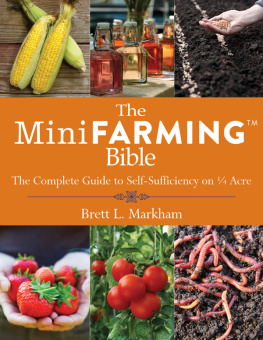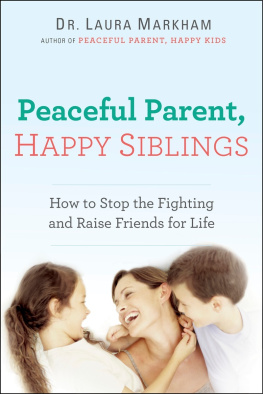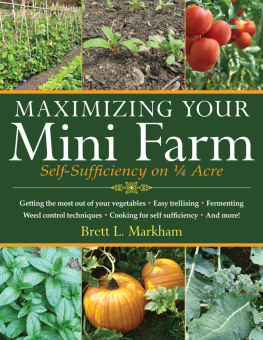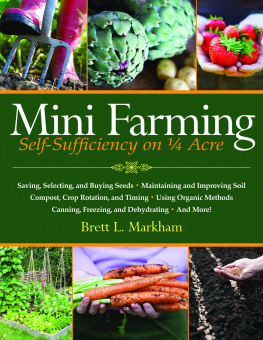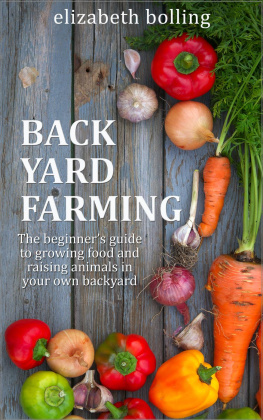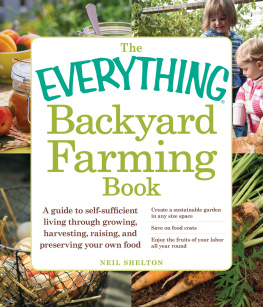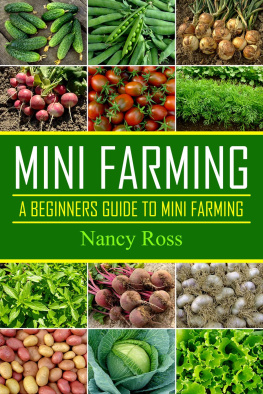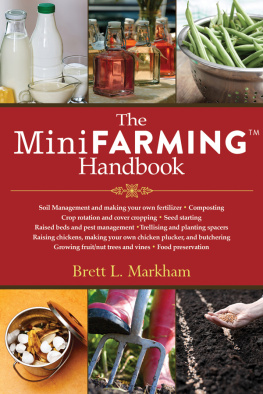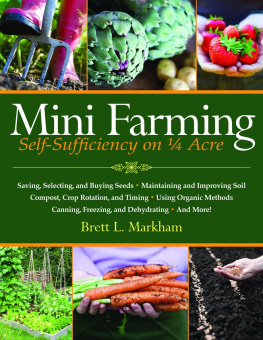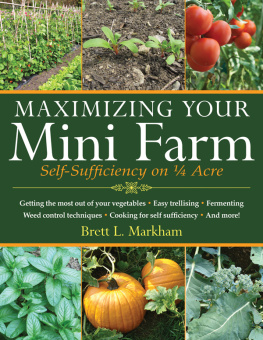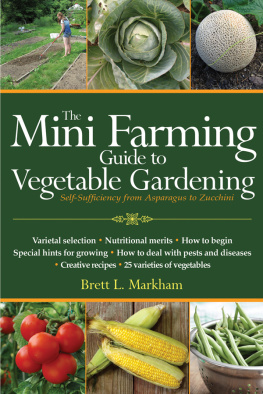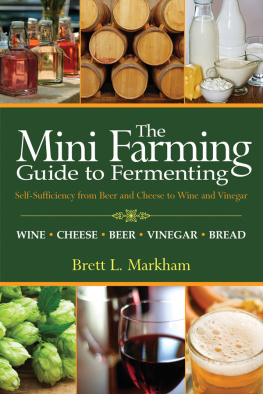Markham - The mini farming bible: the complete guide to self-sufficiency on 1/4 acre
Here you can read online Markham - The mini farming bible: the complete guide to self-sufficiency on 1/4 acre full text of the book (entire story) in english for free. Download pdf and epub, get meaning, cover and reviews about this ebook. City: New York;NY, year: 2014;2013, publisher: Skyhorse Publishing, genre: Children. Description of the work, (preface) as well as reviews are available. Best literature library LitArk.com created for fans of good reading and offers a wide selection of genres:
Romance novel
Science fiction
Adventure
Detective
Science
History
Home and family
Prose
Art
Politics
Computer
Non-fiction
Religion
Business
Children
Humor
Choose a favorite category and find really read worthwhile books. Enjoy immersion in the world of imagination, feel the emotions of the characters or learn something new for yourself, make an fascinating discovery.
The mini farming bible: the complete guide to self-sufficiency on 1/4 acre: summary, description and annotation
We offer to read an annotation, description, summary or preface (depends on what the author of the book "The mini farming bible: the complete guide to self-sufficiency on 1/4 acre" wrote himself). If you haven't found the necessary information about the book — write in the comments, we will try to find it.
Markham: author's other books
Who wrote The mini farming bible: the complete guide to self-sufficiency on 1/4 acre? Find out the surname, the name of the author of the book and a list of all author's works by series.
The mini farming bible: the complete guide to self-sufficiency on 1/4 acre — read online for free the complete book (whole text) full work
Below is the text of the book, divided by pages. System saving the place of the last page read, allows you to conveniently read the book "The mini farming bible: the complete guide to self-sufficiency on 1/4 acre" online for free, without having to search again every time where you left off. Put a bookmark, and you can go to the page where you finished reading at any time.
Font size:
Interval:
Bookmark:

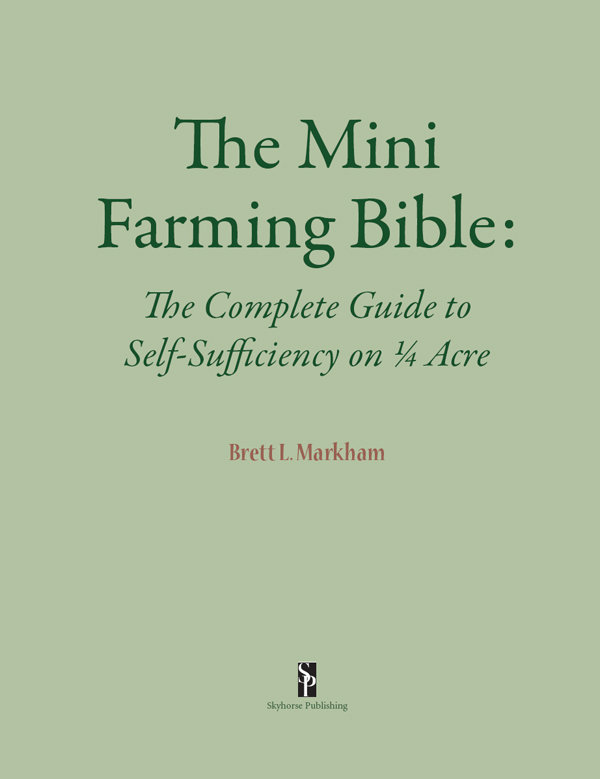
Copyright 2014 by Brett L. Markham
All rights reserved. No part of this book may be reproduced in any manner without the express written consent of the publisher, except in the case of brief excerpts in critical reviews or articles. All inquiries should be addressed to Skyhorse Publishing, 307 West 36th Street, 11th Floor, New York, NY 10018.
Skyhorse Publishing books may be purchased in bulk at special discounts for sales promotion, corporate gifts, fund-raising, or educational purposes. Special editions can also be created to specifications. For details, contact the Special Sales Department, Skyhorse Publishing, 307 West 36th Street, 11th Floor, New York, NY 10018 or .
Skyhorse and Skyhorse Publishing are registered trademarks of Skyhorse Publishing, Inc., a Delaware corporation.
Visit our website at www.skyhorsepublishing.com.
10 9 8 7 6 5 4 3 2 1
Library of Congress Cataloging-in-Publication Data is available on file.
Print ISBN: 978-1-62914-490-0
Ebook ISBN: 978-1-63220-047-1
Printed in China
For my daughter, Hannah
Contents
Introduction

Welcome to The Mini Farming Bible! I am pleased to say that The Mini Farming Bible is comprehensive, containing everything you need to know to support yourself and your family on a minimal amount of real estate.
In an effort to reduce my food bills while still providing plentiful and wholesome food for my family, I started work on the Mini Farming concept in 2004. My backyard became a laboratory for trying different methods of growing plants, breeding varieties tailored to my locale, controlling pests, making compost, raising chickens, growing fruits, and so much more. I tried many popular methods, noted their strengths and weaknesses, and made constant incremental improvements until I arrived at the method I call Mini Farming.
Wholesome food is important for good health, and it is unfortunately rare for Americans to eat enough fruits and vegetables. In my research, I discovered there are three primary barriers that prevent people from eating enough fruits and vegetables: cost, taste, and sugar addiction.
On a calories per dollar basis, fresh fruits and vegetables are some of the most expensive foods available outside of fine wines, caviar, and similar luxury items. On a limited budget, a box of instant macaroni and cheese or cereal will get you a lot more calories for your dollar than carrots or apples. You can get up to 350 calories per dollar using a fast-food dollar menu, or 250 calories per dollar when choosing a candy bar. You'd have to spend $10 on tomatoes to get that many calories. In essence, vegetables are not affordable enough to form a major portion of many people's diets. Growing your own vegetables cost effectively solves this problem.
Taste is also a factor. Most vegetables you can buy at the store are not particularly tasty. There are many reasons for this. In commercial agriculture, even organic agriculture, crop varieties are selected on the basis of shipping and keeping qualities so that they arrive at the grocery store looking good. The problem is that the variety of a crop best-suited for mechanical harvesting and shipping 3,000 miles in a truck is unlikely to be the variety that tastes best. Some crops, such as tomatoes, are harvested before they are ripe and then artificially ripened with ethylene gas, so they don't develop the flavor complexity and sweetness of a naturally ripened product.
Taste is also affected by the time between harvest and purchase, which can be as long as a month for some products. The term fresh merely means it hasn't been frozen, it doesn't mean it was harvested yesterday. Taste is also affected by the way the product is grown, and the way commercial agriculture operates is not conducive to creating the most flavorful vegetables.
If you think about it, this makes sense. Vegetables are bought and sold on a commodity market where a carrot is a carrot is a carrot. If you are a farmer, you'll get the same price for a carrot grown for the best flavor and nutrition as you will for a bland carrot. The biggest factor in grading your carrot is its visual aesthetic, its color and lack of visible blemishes. The fact it tastes vaguely of turpentine (thus discouraging a kid from wanting seconds) is irrelevant. So, of course, we have lots of nice-looking vegetables at the supermarket that don't taste good enough to tempt us to eat them in quantities conducive to good health.
Growing your own vegetables also solves this problem. When you grow your own, you can select the varieties that taste best. As you aren't mechanically harvesting or shipping them 3,000 miles on a truck, you can select for flavor and allow foods to ripen naturally. You can supply all the micronutrients they need and provide optimum fertility. My daughter, Hannah, hates celery, but loves the celery that I grow. Until she started eating my salads, she would sing a song about salads: Icky salad, I want to burn it, so I don't have to eat it.... But once I convinced her to try the salads made from my homegrown vegetables, she looked forward to them as her favorite part of a meal. I even convinced her to eat them for breakfast! Vegetables you grow yourself really are that good. They're so good you'll eat a lot of them. It's not unusual for me to pick and eat a cucumber right off the vine or pick some mustard leaves and shove them into my mouth while I'm out back. Delicious!
The third cause of inadequate vegetable consumption is addiction to both direct and indirect sugar. Concentrated sugars and high carbohydrate diets are relatively new on the human scene, and they can cause both physiological and psychological addiction. Because of this, when a choice is available, the sugar-laden alternative is chosen. Though starting a mini farm won't fix this, I've written a book, Modern Caveman , that discusses sugar addiction in-depth and gives solutions.
So Mini Farming solves the problems of cost and taste, encouraging optimum levels of vegetable consumption for a healthy life. But it does more than that.
Mini Farming enhances your health through providing movement that maintains your proprioception, balance, and flexibility. In addition, because the food is more fresh, it can contain as much as 300% more of some nutrients than the food you buy at the store. Even better, using Mini Farming methods will enhance the micronutrient content of your food, and many experts believe that the deficiency of micronutrients in our food supply is indirectly responsible for a host of human ills. Simply on the basis of health alone, Mini Farming is a good idea.
But Mini Farming is about more than physical health, it's about economic health as well. Gardening is a hobby. Farming is an economic pursuit. Mini Farming can certainly be a hobby, but it is fundamentally an economic pursuit designed to produce the greatest amount of the healthiest food for the least amount of investment in terms of real estate, time, and money. The fact that it is enjoyable and gives you healthy exercise is a bonus.
Usually, the goals of food being healthy AND taking less time and money are a zero-sum game. If you go to the grocery store to buy organic food, you'll find it can cost as much as 500% more than conventionally-grown food of the same type. Likewise, many of the small-space gardening techniques in vogue may work well on the scale of a hobby, but when you try to increase them enough to support a family, they are either inordinately time consuming for modern American lifestyles, or they become too expensive.
Font size:
Interval:
Bookmark:
Similar books «The mini farming bible: the complete guide to self-sufficiency on 1/4 acre»
Look at similar books to The mini farming bible: the complete guide to self-sufficiency on 1/4 acre. We have selected literature similar in name and meaning in the hope of providing readers with more options to find new, interesting, not yet read works.
Discussion, reviews of the book The mini farming bible: the complete guide to self-sufficiency on 1/4 acre and just readers' own opinions. Leave your comments, write what you think about the work, its meaning or the main characters. Specify what exactly you liked and what you didn't like, and why you think so.

